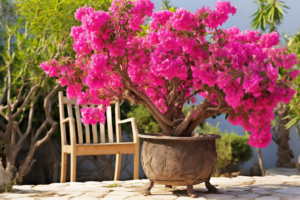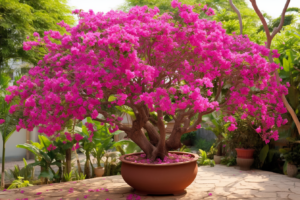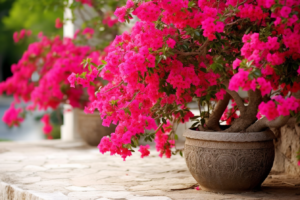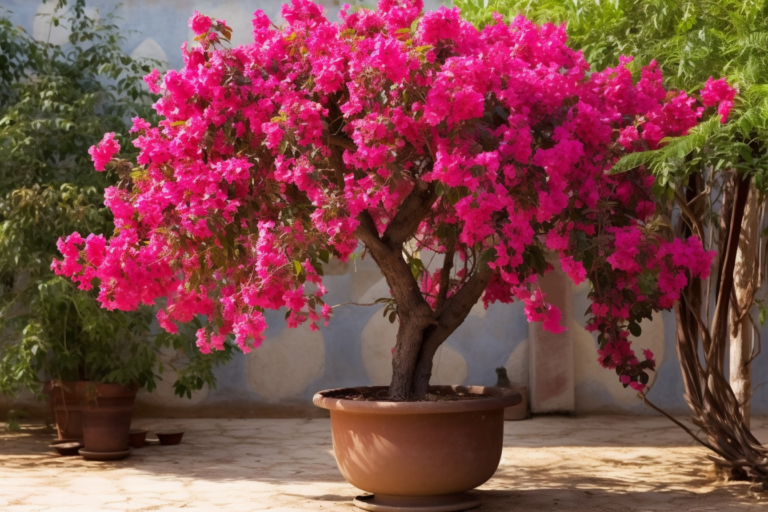Have you ever found yourself wondering how often to water bougainvillea? These vibrant, tropical plants can be a stunning addition to any garden or landscape, but their care requirements are different from those of other plants. In this article, we will delve deep into the world of bougainvillea and discover the secrets to maintaining a healthy, well-hydrated plant.
Understanding Bougainvillea
Before we can answer the question of how often to water bougainvillea, it’s important to understand the plant itself.
Types of Bougainvillea
There are many types of bougainvillea, ranging from small shrubs to large climbers that can reach up to 30 feet in height. The most common varieties include:
- Bougainvillea glabra: Known for its smooth, almost thornless stems and small, colorful bracts.
- Bougainvillea spectabilis: Characterized by large, vibrant bracts and thick, thorny stems.
- Bougainvillea peruviana: A more compact variety with small, tubular flowers and stiff, thorny stems.
Caring for Bougainvillea
Bougainvillea plants prefer warm climates, full sunlight, and well-draining soil. They are relatively drought-tolerant, but still require regular watering to thrive.
Watering Requirements
Now that we have a better understanding of bougainvillea, let’s dive into their watering requirements.
Factors Influencing Watering Frequency
There is no one-size-fits-all answer to how often bougainvillea should be watered. The frequency depends on several factors, including:
- Climate: In hot, dry climates, bougainvillea may need to be watered more frequently to compensate for increased evaporation.
- Soil type: Fast-draining soil may require more frequent watering, while slow-draining soil may need less.
- Plant size and age: Younger, smaller plants generally need more frequent watering than larger, established plants.
As a general rule of thumb, bougainvillea should be watered when the top 2-3 inches of soil feel dry to the touch.
Signs of Overwatering and Underwatering
It’s important to monitor your bougainvillea for signs of overwatering or underwatering. Overwatered plants may exhibit yellowing leaves, root rot, and a lack of blooms. Underwatered plants may have wilting leaves , drooping branches, and a general lack of vigor. By paying attention to these symptoms, you can adjust your watering schedule accordingly.
How Much Water Does Bougainvillea Need?
As an expert on gardening, I often get asked about the proper way to water bougainvillea. It’s a great question because bougainvillea is a popular plant due to its vibrant colors and ability to grow easily in warm climates. In this section, I’ll discuss how much water bougainvillea needs to thrive.
First of all, it’s important to note that too much water can harm bougainvillea just as much as too little. Overwatering can lead to root rot and other issues, while underwatering can cause the plant to dry out and eventually die.

So, how much water is the right amount for bougainvillea? The answer depends on a few factors such as the climate, soil type, and age of the plant. In general, your goal should be to keep the soil moist but not soggy.
During the growing season, which is typically in the spring and summer months, you’ll want to water your bougainvillea every 2-3 days. However, if you live in a hot, dry climate, you may need to water more frequently. On the other hand, if you live in a cooler, more humid climate, you may be able to water less frequently.
When watering your bougainvillea, make sure to give it a deep watering. This means letting the water soak through the soil and reach the roots. You can achieve this by watering slowly and steadily until you see water coming out of the drainage holes at the bottom of the pot or container.
During the winter months or when bougainvillea is not in its growing season, you’ll want to reduce your watering frequency. Water your plant only when the soil feels dry to the touch, usually every 7-10 days.
Overall, the key to watering bougainvillea is to find a balance that works for your specific plant and environment. By keeping the soil moist but not waterlogged, you can help your bougainvillea thrive and produce beautiful blooms.
Here’s a table to summarize the information discussed:
| Season | Watering Frequency | Soil Moisture Level |
|---|---|---|
| Spring and Summer | Every 2-3 days (or more in hot/dry climates) | Moist but not soggy |
| Fall and Winter | Every 7-10 days (or when soil feels dry to the touch) | Moist but not waterlogged |
What is the Best Time of Day to Water Bougainvillea?
When it comes to watering bougainvillea, the timing is just as important as the amount of water you give it. Watering at the right time of day can maximize the plant’s water absorption and minimize the risk of fungal diseases. So, what is the best time of day to water bougainvillea?
The answer is early morning. Watering in the morning allows the soil to absorb the moisture and for the plant to take up the water before the sun and heat increase the evaporation rate. This also ensures that any excess moisture on the leaves and stems can quickly dry out during the day rather than sitting on the plant and causing issues.
Another benefit of watering in the morning is that it gives the plant enough time to dry before nightfall. Moisture on the leaves and stems overnight can lead to fungal diseases, which is something you definitely want to avoid.
Watering at night is the absolute worst time to water your bougainvillea. As mentioned earlier, watering at night leaves the plant damp and increases the likelihood of fungal diseases. It also increases the risk of attracting pests and insects that can harm your plant.
While the morning is the best time to water your bougainvillea, you can also water it in the late afternoon when the sun is not as intense. However, avoid watering in the evening because, as we have mentioned, it hinders the plant’s ability to grow and increases the chance of disease.
Furthermore, It is essential to remember that bougainvillea doesn’t do well in waterlogged soil. So, don’t water it excessively or too frequently, regardless of the time of day.
In summary, the best time of day to water bougainvillea is in the morning. It allows the plant to take up water and avoid the heat and evaporation while giving it enough time to dry before nightfall. Avoid watering at night and never waterlogged the soil, regardless of the time of day.
How to Water Bougainvillea in Containers or Pots?
If you have bougainvillea growing in a container or pot, it’s essential to provide the plant with the right amount of water to ensure its growth and health. The following tips will tell you exactly how to water bougainvillea in containers or pots:

- Check the soil moisture: Before watering your bougainvillea, always check the moisture level of the soil. One way to do this is to stick your finger into the top 1-2 inches of soil. If it feels dry, then it’s time to water. However, if the soil feels moist, wait a day or two before checking again.
- Water deeply and infrequently: When you do water your bougainvillea, make sure to water it deeply. This means giving it enough water to hydrate its roots, not just the surface. Watering frequently but superficially can lead to shallow roots and poor plant growth. Depending on the size of the container, your bougainvillea may need watering once or twice a week. Ensure that the soil drains well, or else the water could collect in the bottom, causing root rot.
- Water in the morning: Preferably, water your bougainvillea in the morning. This timing will allow the plant to absorb the moisture before the intense afternoon sun and high temperatures evaporate water from the soil before it’s absorbed. Avoid watering your bougainvillea at night, as the leaves will stay damp, leaving the plant prone to diseases and fungal infections.
- Adjust watering frequency: Your bougainvillea will need more or less water depending on the environment. Observe the plant for signs of under or over-watering, like wilted leaves or yellowing foliage. If the weather is hot or dry, or if the pot is positioned in direct sunlight, the plant may need more water.
By following these tips, you can ensure that your bougainvillea flourishing in its container or pot.
How to Water Newly Planted Bougainvillea?
Proper watering is crucial for the survival of newly planted bougainvillea. Here are some tips on how to water them effectively:

- Watering frequency: For the first six months after planting, water your bougainvillea every day. This frequent watering ensures the plant receives enough moisture to establish the roots properly.
- Amount of water: Provide enough water to saturate the soil around the root ball, but be careful not to overwater. Overwatering can cause root rot and the plant will die. If the soil becomes waterlogged, the plant may become stressed and susceptible to diseases.
- Time of day: Water newly planted bougainvillea early in the morning or late in the afternoon when the sun is less intense. Watering during the hottest part of the day can cause the water to evaporate before the plant can absorb it.
- Watering method: Avoid overhead watering, as this can cause diseases to spread easily. Instead, use drip irrigation or a soaker hose to deeply water the plant’s roots.
- Soil type: Bougainvilleas prefer well-draining soils, so be sure to plant them in a well-drained soil mix. Clay soils should be amended with sand, vermiculite, or perlite to improve drainage.
By following these watering guidelines, your newly planted bougainvillea will thrive and grow into a beautiful plant with a profusion of vibrant flowers. Remember to adjust your watering schedule as the plant matures and develops a more extensive root system.
What is the Best Soil for Bougainvillea?
As an expert gardener, I am often asked about the best soil for bougainvillea. Bougainvillea is a tropical plant that loves well-draining soil and thrives in full sun. The key to growing healthy bougainvillea is choosing the right soil mix.
Here are some factors to consider when selecting soil for your bougainvillea:
1. pH level
Bougainvillea thrives in a slightly acidic soil with a pH level between 5.5 and 6.5. If the soil is too alkaline, the plant may experience nutrient deficiencies, which can lead to poor growth and flower production.
2. Texture
Bougainvillea’s roots need oxygen and don’t like to stay wet. Therefore, a well-draining, gritty soil mix is ideal. You can mix your soil with some sand or perlite to increase its drainage capacity. Bougainvillea also prefers a loose and airy soil texture, which helps promote root growth.
3. Nutrient content
Bougainvillea grows best in soil with a high content of organic matter. Therefore, you can mix your soil with compost or well-rotted manure, which provides the necessary nutrients and minerals. Additionally, you can use slow-release fertilizers that contain balanced micronutrients to supplement the soil.
4. Moisture retention
Bougainvillea likes to be kept on the dry side and does not tolerate waterlogged soil well. Therefore, your soil mix should be moist but not waterlogged. Good drainage is key to preventing root rot and ensuring that the roots get enough oxygen.
In summary, the best soil for bougainvillea is a slightly acidic, well-draining, gritty mix with a high content of organic matter. It’s also essential to ensure that the soil is moist but not waterlogged to prevent root rot. By taking care of the soil requirements of bougainvillea, you can enjoy beautiful, vibrant blooms year-round.
Thanks for the reminder. Here’s the section on “How to Fertilize Bougainvillea?”
How to Fertilize Bougainvillea?
Proper fertilization is crucial for bougainvillea plants to thrive and produce vibrant and colorful blooms. Here are some tips on how to fertilize your bougainvillea:
- Start fertilizing in early spring – Bougainvillea plants should be fertilized regularly starting from early spring when they begin to produce new growth.
- Use a balanced fertilizer – Choose a fertilizer that has equal or balanced amounts of nitrogen, phosphorus, and potassium. Too much nitrogen can result in excessive vegetative growth and fewer blooms.
- Apply fertilizer every 4-6 weeks – Bougainvillea plants are heavy feeders and require regular fertilization, particularly during the growing season. Apply fertilizer every 4-6 weeks to provide a consistent source of nutrients.
- Water before and after fertilizing – To avoid burning the roots, make sure to water the plant thoroughly before applying fertilizer. After fertilizing, water the plant again to dissolve the fertilizer and distribute it evenly throughout the soil.
- Consider slow-release fertilizers – Slow-release fertilizers can provide nutrients over a longer period, reducing the need for frequent fertilization. However, make sure to follow the manufacturer’s instructions and not apply too much fertilizer.
In summary, regular fertilization is essential for the health and beauty of your bougainvillea plant. Be sure to choose a balanced fertilizer, apply it every 4-6 weeks during the growing season, and water the plant before and after fertilizing. By following these tips, you can enjoy a stunning display of colorful blooms all season long.
Thank you for the clarification. Here’s the markdown for the requested section on pruning bougainvillea:
How to Prune Bougainvillea?
Pruning is an essential task to keep your bougainvillea plant in good health, maintain its shape, and promote blooming. Here are some tips on how to prune your bougainvillea effectively:
- Timing: The best time to prune your bougainvillea is in early spring, right before the growing season begins. Pruning at this time will encourage new growth and more blooms during the blooming season.
- Tools: Use sharp and clean pruning shears to make clean cuts. Avoid using dull or rusty tools as this can damage the plant.
- Technique: When pruning, remove dead and diseased branches, cutting them back to the main stem. Cut back any branches that interfere with the plant’s shape or that rub against each other. Don’t be afraid to prune aggressively as bougainvillea plants are very resilient.
- Growth: Pruning can help increase bushiness in bougainvillea plants. Cut back longer branches to promote new growth and encourage more blooms.
- Maintenance: Prune bougainvillea regularly to keep the plant in check and prevent it from becoming overgrown. Plan on pruning at least once a year, or more often if needed.
Remember, bougainvillea plants have thorns, so wear gloves and long sleeves when pruning. Pruning can also be a great time to inspect the plant for any signs of pests or diseases. Keeping up with regular pruning and maintenance will help keep your bougainvillea looking healthy, vibrant, and full of blooms.
FAQS
Can bougainvillea be grown indoors?
Yes, bougainvillea can be grown indoors if provided with enough light, usually through a south-facing window or with supplemental artificial lighting.
How much sunlight does bougainvillea need?
Bougainvillea thrives in full sun, requiring at least 6-8 hours of direct sunlight per day to produce vibrant blooms.
Can I propagate bougainvillea from cuttings?
Yes, bougainvillea can be propagated from semi-hardwood cuttings taken during the growing season. Root the cuttings in well-draining soil and keep them moist but not soggy.
How long does it take for bougainvillea to bloom?
Bougainvillea typically blooms within 3-5 years of planting, depending on the variety and growing conditions.
Are bougainvillea plants poisonous?
Bougainvillea plants are not considered poisonous to humans, but their sharp thorns can cause injury. Some pets may experience mild gastrointestinal upset if they ingest the plant.


I have been struggling with how often to water my bougainvillea, but this article gave me all the information I needed. Thank you!